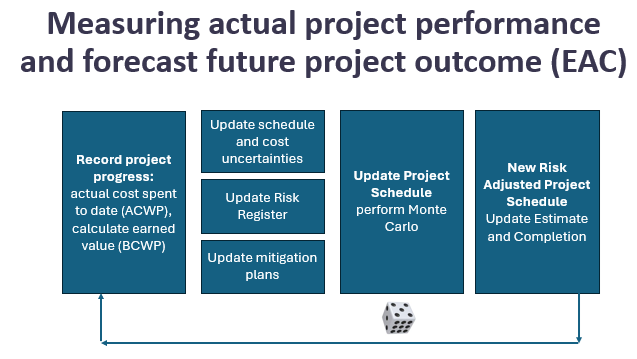Many organizations utilize a more advanced framework for measuring project performance called Earned value management (EVM). EVM was first developed in the 1960s but became a practical methodology late in the last century when it was actively adopted by U.S. government agencies and in particular the U.S. Department of Defense.
EVM models include three main components:
- Project schedules with actual performance data such as such as percent completed for each task,
- Indicators which show the value of planned work, such as Planned Value (PV) or Budgeted Cost of Work Scheduled (BCWS), and
- Indicators or metrics, which quantify how much work was performed, such as Earned Value (EV) or Budgeted Cost of Work Performed (BCWP).
The main idea behind EVM is to measure project progress by calculating Earned Value versus Planned Value over time. The projects can have many other indicators, including Schedule variance (SV), Budget at completion (BAC), and Cost variance (CV). The most common metrics for integrated EVM and risk analysis are:
- The Schedule Performance Index (SPI), which is determined by dividing earned value (EV) by planned value (PV).
- The Cost Performance Index (CPI), which is determined by dividing earned value (EV) by actual cost.
- Create a resource-loaded and cost-loaded project schedule.
- Identify risks and uncertainties and assign them to the project tasks.
- Perform Monte Carlo simulation using integrated schedule and cost risk.
- The risk adjusted project schedule becomes a baseline profile (BCWS/PV); this risk adjusted project schedule can be generated based on certain confidence levels (e.g. 80%).
- Record project progress and actual cost spent to date (ACWP), and calculate earned value (BCWP).
- Review initial time/cost estimates for activities not completed, identify changes, including revised estimating uncertainties expressed as statistical distributions of project duration and costs.
- Update risk identification, assessment and quantification: update probabilities and impacts of the risks, review mitigation and response plans.
- Update project schedule and repeat Monte Carlo simulation; essentially the simulation is performed on remaining project work, although the simulations are done using the entire schedule.
- Select risk-adjusted project schedule defined using certain confidence level as estimate of final project duration and cost (EAC).
- Select EVM metrics, for example CPI and SPI to trigger corrective action in risk process and calculate them.
- Consider modifications to risk processes, for example perform risk mitigation if CPI and/or SPI cross thresholds.
- Consider the need to review initial baseline or scope if CPI and/or SPI persistently have unusually high or low values.
How can we integrate project risk analysis with established EVM processes? Here are the basic steps to integrate EVM/Project Risk Analysis Process
Step 1. Create the baseline spend plan (BCWS/PV)
Step 2. Measure actual project performance and forecast future project outcome (EAC)
Step 3. Evaluate the risk management process’ effectiveness
In conclusion, we use EVM to manage risk adjusted project schedules. We calculate all necessary metrics at each phase of the project, and based on these metrics; perform corrective actions to reduce the impact of specific threats or exploit opportunities.


